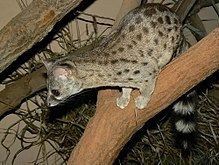Kingdom Animalia Order Carnivora Subfamily Viverrinae Scientific name Genetta thierryi Rank Species | Phylum Chordata Family Viverridae Genus Genetta Higher classification Genet | |
 | ||
Similar Crested servaline genet, King genet, Abyssinian genet, Angolan genet, Johnston's genet | ||
The Haussa genet (Genetta thierryi) is a genet species native to West African savannahs. It is listed as Least Concern on the IUCN Red List.
Contents
Haussa genets have been sighted in Senegal's wooded steppes, in moist woodlands in Guinea-Bissau, and in rainforest in Sierra Leone, Ghana and Ivory Coast.
Characteristics
The Haussa genet has a bright colored fur with short hair. A brown-rufous continuous line along its back is longitudinally crossed by a brighter colored line. Its feet are as bright as the ground coloration. Its tail is banded with dark and bright rings and a black tip. Its marking consist of two rows of elongated dorsal spots. The spots on shoulder, thigh and flank are smaller and darker. Its forelimbs and hindlimbs are not spotted. It differs in colouring and length of hair in relation to its habitat, the pelage being shorter and paler in savannah-type habitat, and longer and darker (more yellow) in forest habitat. The guard hairs at the base of the spatula are round, or very slightly ovoid, which is unique among genets.
Distribution and habitat
The Hausa genet is native to Gambia, Guinea-Bissau and Cameroon, where it inhabits moist and dry savannas with open woodlands. It has also been sighted in dry wooded steppes in Senegal, and in rainforest in Sierra Leone, Ghana and Côte d’Ivoire.
Ecology and behavior
The ecology of the Haussa genet has been little studied. Its foraging behaviour and diet is likely to be similar to that of other genets. Its breeding behaviour is also unknown, but these genets are thought to make dens among boulders or in holes dug into the ground. A juvenile was found sleeping in a hollow tree, and two half-grown animals were found in Mali in November, which may indicate that pups were born between January and March.
Threats
It is hunted in some areas and sometimes seen on display as bushmeat. The scale and impact of this threat is not known.
